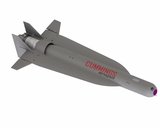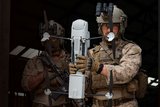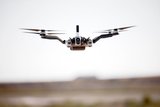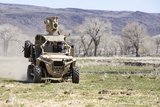California National Guard begins domestic Predator operations
The sounds of cheers and applause filled the air Feb. 25 as an MQ-1 Predator from the 163rd Reconnaissance Wing lifted off the runway here at Southern California Logistics Airport (SCLA) marking the Air National Guard’s first Predator flight in the United States.
The Predator, an unmanned aerial system (UAS), has been in use for more than 10 years, but only active-duty Air Force operated the system until the 163rd received the mission in 2006.
Since then, the unit has been a trailblazer for the National Guard. It was the first Guard wing to receive the Predator mission and the first to open a Predator-maintenance schoolhouse.
Now the wing has added two more feats to its list of accomplishments: the first domestic flight and the first to open an ANG training school to instruct Airmen to fly and operate the aircraft.
The Predator’s maiden U.S. voyage for the 163rd was piloted by 196th Reconnaissance Squadron pilot Maj. Eric Fagerland, who said his main objectives on the flight were to scout the surrounding area for factors that might hinder future operations and to evaluate the aircraft’s equipment and functionality.
During the flight, Master Sgt. Justin Ciasullo of the 196th operated the “sensor ball,” which houses the Predator’s optics, lasers and video cameras. He used the sensor ball to explore the airport’s four runways and to ensure the Predator’s approach and landing systems were properly configured for the airfield.
“The aircraft performed as advertised,” Ciasullo said.
He and Fagerland had planned to hand control of the aircraft over to a crew at March Air Reserve Base about 40 miles away, but weather constraints prevented them from completing that part of the mission.
“We didn’t accomplish everything we wanted to on this flight due to the weather; however, the impact of this first flight to the Formal Training Unit’s (FTU) development is as important as anything we’ve done so far,” said Lt. Col Kirby Colas, 196th RS commander. “It definitely feels good to have a tangible success under our belt to validate the years of effort we’ve put into making the FTU happen.”
During the Feb. 25 flight, the Predator was flown in the immediate area of SCLA.
Since then, the aircraft’s route of travel has included the restricted airspace over Edwards Air Force Base, 20 miles north of SCLA, and the unpopulated desert between Edwards and SCLA.
The first nine-week FTU class is scheduled to begin later this month. The 163rd is planning to hold five classes each year, with about 10 students per class. The only other training unit for flying MQ-1 Predators is run by active-duty Airmen at Creech Air Force Base, Nev.
There are two operational Predators based at SCLA, but only one aircraft flies at a time. The 163rd has received a third Predator, but leadership has not decided if the aircraft will be based at SCLA or at March Air Reserve Base.
163rd Operations Group commander Col. Randall Ball said the first Predator flight at SCLA was a great display of “Grizzly can-do attitude, innovation and teamwork,” which he expects to continue as UAS technology advances.
“As the Predator production line closes, we look forward to transitioning to the MQ-9 Reaper, which is a more capable and advanced [UAS] platform,” he said. “The horizon is wide open for the UAS. It’s a growing industry, which eventually could encompass aerial combat, electronic warfare and cargo platforms.”
By Senior Airman Paul Duquette - California National Guard
More from Uncrewed Vehicles
-
![Cummings Aerospace showcases Hellhound loitering munition designed for US Army’s LASSO programme (video)]()
Cummings Aerospace showcases Hellhound loitering munition designed for US Army’s LASSO programme (video)
Cummings Aerospace presented its turbojet-powered Hellhound loitering munition at SOF Week 2025, offering a man-portable solution aligned with the US Army’s LASSO requirements.
-
![SOF Week 2025: PDW unveils attritable FPV drone for SOF operations at scale]()
SOF Week 2025: PDW unveils attritable FPV drone for SOF operations at scale
PDW has revealed its Attritable Multirotor First Person View drone at SOF Week 2025, offering special operations forces a low-cost, rapidly deployable platform for strike and ISR missions, inspired by battlefield lessons from Ukraine.
-
![SOF Week 2025: Teledyne FLIR white paper provides guidance on reusable loitering munitions]()
SOF Week 2025: Teledyne FLIR white paper provides guidance on reusable loitering munitions
Teledyne FLIR is highlighting the emerging requirements for 'recoverable and re-usable' loitering munitions across the contemporary operating environment during this week’s SOF Week conference in Tampa, Florida.
-
![SOF Week 2025: Kraken Technology group debuts K3 Scout USV in North America]()
SOF Week 2025: Kraken Technology group debuts K3 Scout USV in North America
High-performance maritime industry player Kraken Technology Group, based in the UK, has used the SOF Week conference in Tampa, Florida this week to debut its K3 Scout uncrewed surface vessel (USV) to the North American market.
-
![Palladyne AI and Red Cat to demonstrate capabilities for autonomous drone swarms to the US military]()
Palladyne AI and Red Cat to demonstrate capabilities for autonomous drone swarms to the US military
Red Cat and Palladyne AI recently conducted a cross-platform collaborative flight involving three diverse heterogeneous drones.
-
Jammer resistant drone designs spark search for countermeasures
The Russia-Ukraine conflict has driven another stage of evolution for drones and the counter measures to defend against them.

























